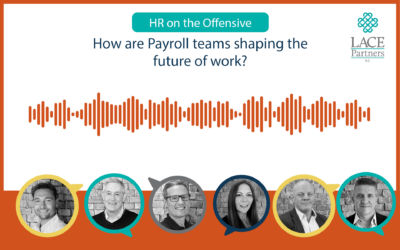How can organisations use the performance management process to drive business outcomes, rather than use them merely as a ‘tick box’ exercise? In a recent HR on the Offensive podcast we discussed this with Roly Walter, founder of Appraisd and below is an overview of some of the key topics of discussion.
What is an outcomes-driven performance culture?
Outcomes-driven cultures are the antithesis of output-based cultures. The aim is to get everybody in an organisation to think about what the outcomes are that they are working to create, rather than the tactical outputs that they themselves must deliver on from a day-to-day basis.
In an organisation that focuses on being outcomes driven, you would typically see a focus on measuring performance based on customer or business outcomes, rather than what an individual has achieved in isolation or a silo (which could also be from a team silo perspective too). As an example, a business outcome is linked to increasing revenue or market share, or a customer outcome might be a process to order your product online easier, like a family booking a holiday, etc. So, when you talk about being outcomes-driven you are focusing on how at a micro/individual level (the employee) you can align performance to that of the macro performance of the organisation. The focus shifts towards getting employees to think about how they can achieve those outcomes using their own methods.
Sounds rather simple, right? Well, yes, in principle it is, but it is amazing how many organisations do not adopt this approach. Too many use the performance management process as a ‘tick box’ exercise, designed to satisfy a business principle that “we have always undertaken performance management this way”.
The recent shift to remote working has also seen a change in mindset in how organisations can deliver on greater productivity for their people. What we have seen at Appraisd is this switch to a focus on finding solutions that can link the individual performance and productivity to the outcomes of the business, as well as what organisations want their employees to achieve.
This has also had a positive impact from an employee perspective, because you are asking people to be self-organising it gives them a certain amount of freedom and autonomy to find the best way to deliver the outcomes.
How do you manage an individual’s success and ensure it contributes on a team and wider business level?
One of the challenges organisations have is the difficulty defining outcomes. There are various frameworks organisations can use to measure that individual contributor performance. For example, if you’re using ‘Objectives and Key Results’ (OKRs) you might think of individual initiatives which are tasks an individual has to deliver, to help achieve the team’s OKR as a whole.
Many employees don’t know what their companies’ goals actually are, so communication and being able to articulate strategic objectives is crucial. For our system at Appraisd, one of the key pillars we work hard with our customers on is alignment. Select objectives for individuals that ensure that everybody is performing to their best and doing the work that most aligns with the company’s objectives and goals.
It’s quite easy for managers to forget how crucial it is for them to keep echoing the company’s objectives constantly. Additionally, you need to be enthusiastic about them and to involve these objectives into everything you’re saying and doing. It is the job of the senior leader to get everyone onboard with these objectives to prevent missing vital information.
The three pillars of performance management
At Appraisd we are trying to help organisations execute on their strategy. They’ve chosen their strategy and we help them improve on delivering the strategy not just currently but also to make it sustainable for the future. In order to achieve this, we’ve chose three ways to tackle the problem. We break that in to three core pillars.
First is through performance. Our system includes performance reviews, competency evaluations, skills development just to mention a few. We want to get people to perform at their best and enjoy doing so. The second pillar, mentioned above, is alignment. This can be attained through goals that contribute to other people’s or department’s goals which allows us to see how everything feeds into the company’s overall goal. The final pillar is concerned with how we get this execution on strategy over the longer term and that is through the progression of your people. We all know how important it to retain your talent. One of the best ways to do that is to give them a sense of purpose and progression. Hence, the progression side of the application which helps people understand and get to grips with their career goals, development needs, what they need to work on to obtain the praise and recognition that they value so much.
How can businesses get better at using data to drive these three pillars?
The most of what we do is online. This means that typically the data is out there; it could be sales figures in a CRM, it could be data from Google Data Studio. Quite often the data does exist and if it doesn’t then you may need to invest time in gathering that data and looking at the analytics. For example, if you don’t know how many customer tickets are being sold per day, you need to make it a priority to acquire that data.
The second challenge after gathering all that data, and most organisations already do, is that it tends to be available in one dashboard or another. Unfortunately, it is not part of the typical management practices to refer to that data as often as they should. One of our clients is a large recruitment organisation, where they check in with the Appraisd system every quarter. In that particular check in they pull in data from Microsoft Power BI. The employees answer general wellbeing questions but are then presented with their results from the last quarter allowing them to review their progress and where they can improve in the next quarter. You are able to integrate these data sources more easily now than you could have done four years ago.
How many businesses are delving into their people performance data and are good at utilising it
Currently only a few businesses are proficient at using data but it’s becoming increasingly pressing. People are asking us or other consultancies that specialise in data analytics for help. I’ve noticed that it’s the smaller companies that really obsess over this. Perhaps it’s the smaller, fast-growing companies that think that there must be a way to link all these data sources together. On the other hand, the older and larger organisations may find it more of a challenge as they may not have the resources internally or potential other issues.
From what we’ve seen in terms of the differences between larger and smaller organisations, it boils down to the fact it is simpler for smaller organisations. However, for larger organisations we are often dealing with legacy systems, or systems that have been transitioned from one into another. This requires us to manage a number of interdependencies. Furthermore, in these smaller organisations there may be a leader or CEO who has had an outcome focus from the start and they see no reason as to why they shouldn’t have access to all that data.
How can you drive performance managers for people that are on short term assignments?
Personally, I think that the technology is an enabler, the new technology can make this fairly easy. The challenge is more of a cultural one; it’s to do with how people habitually consider contractors. Contractors often start off being heavily outcome focused as they are brought into to do a particular job. Eventually they lose that focus and it gets added to the technical solution, if there is one, and they are considered slightly differently. It’s almost a taboo to measure the performance of your contractors in a developmental way, but one that should be broken.
If you’d like to discuss your current approaches to performance management, or you’d like to speak to us about your people planning and strategy, reach out to the team using the form below and we’ll get in touch.






